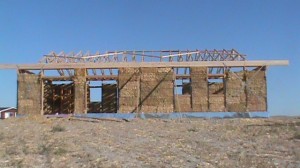In a world too often shrouded from most of America, there’s a renewed perspective and promise of opportunity growing among its people. The Thunder Valley Regenerative Community initiative has inspired the Oglala Lakota Sioux tribe who inhabit the Pine Ridge Reservation ancestral lands in southwest South Dakota to act and plan for important things to come.

The renewal was evident on a recent visit with the Thunder Valley Community Development Corporation’s dynamic young executive director, Nick Tilsen. On this perfect warm autumn day I had an up close glimpse into what the Oyate Omniciye [Circle of Meetings of the People] has created with its 2010 Regional Sustainable Planning grant award from HUD. Wow! The Thunder Valley work is one of the most visionary, inclusive and long term plans completed under this program. It addresses the scarcity of housing, economic development, employment training and, ultimately, job opportunities for Lakota youth and families. Sustainability has been a historic practice of the Lakota people for generations, but the regenerative community plan now provides a current linkage to every Tribal government function.
The 34 acre site lies in the heart of Pine Ridge among low rolling hills adjacent to one of the Reservation’s central road arterials. Thunder Valley has embarked on building four sustainable housing prototypes with architecture and design help from students of the University of Colorado at Boulder, Oglala Lakota College and the South Dakota School of Mines and Technology. These four houses will have the same footprint, but use different construction technologies [Straw Bale Infill; Compressed Earth Block; Structural Insulated Panels and Conventionally Framed] to compare cost and energy savings. The energy usage, air quality, durability, and occupancy of each home will be monitored over a 12 month period in order to determine the best construction type performance relationship to the culture and climate of the Pine Ridge Reservation. The preferred construction technology will anchor the projects single family home types as the master plan gets implemented.
 HUD and its federal agency partners have awarded over $200 million in sustainability grants nationally since 2010. Only a handful of Native communities have competed for these regional planning dollars. Thunder Valley had the foresight to go after the grant funding as a constructive means to address the long standing housing shortage, high unemployment and youth apathy occurring on the reservation. The grant brought together Elders, Tribal leaders and Lakota youth to meet, talk and reach consensus on what life should look like on Pine Ridge in the future. Through numerous community meetings and outreach, all over the vast reservation, came the birth of the Regenerative Project. The project incorporates everyday governance functions larger cities and towns just take for granted and uniquely maintains Lakota culture in language, health and environmental planning decisions.
HUD and its federal agency partners have awarded over $200 million in sustainability grants nationally since 2010. Only a handful of Native communities have competed for these regional planning dollars. Thunder Valley had the foresight to go after the grant funding as a constructive means to address the long standing housing shortage, high unemployment and youth apathy occurring on the reservation. The grant brought together Elders, Tribal leaders and Lakota youth to meet, talk and reach consensus on what life should look like on Pine Ridge in the future. Through numerous community meetings and outreach, all over the vast reservation, came the birth of the Regenerative Project. The project incorporates everyday governance functions larger cities and towns just take for granted and uniquely maintains Lakota culture in language, health and environmental planning decisions.

Pine Ridge and the Lakota people have embarked on, and experienced a way to promote long term hope for a better future. Regional sustainable planning indeed takes many forms, as demonstrated on Pine Ridge, however, it can motivate local communities and diverse interests to come together to seek agreement on how best to improve and meet the future well prepared to act. This may be one of the best outcomes yet of HUD’s regional sustainable planning grant program.

Connect with HUD